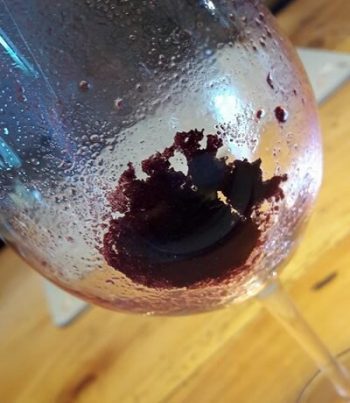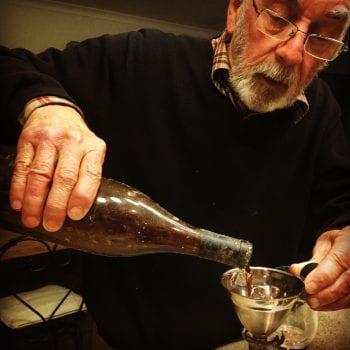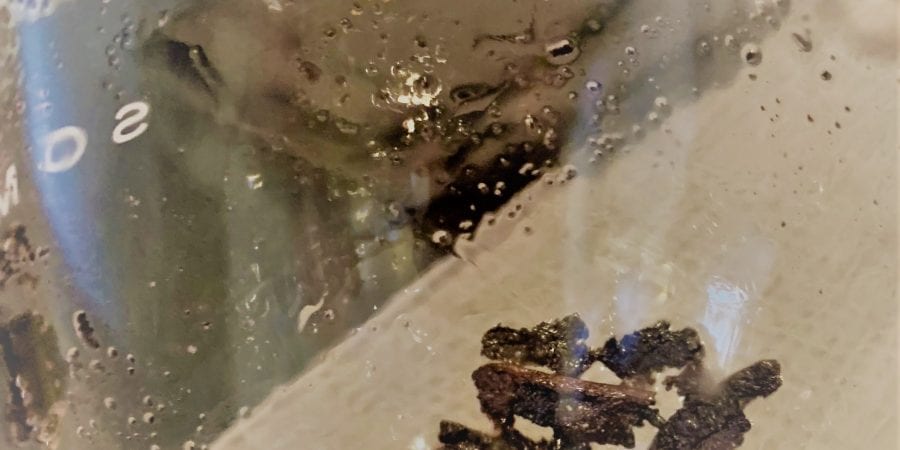When enjoying a bottle of wine, you might encounter an unexpected guest at the bottom of your glass – sediment.
Often mistaken for impurities or signs of spoilage, wine sediment is a natural occurrence that can actually provide insights into the wine’s character and age.
This week, let’s have a look at what it is, why it’s there and how to figure out when you should consider getting rid of it.
What is Wine Sediment and Why Does it Form?
 Wine sediment is the solid particles that settle at the bottom of a bottle or glass of wine over time.
Wine sediment is the solid particles that settle at the bottom of a bottle or glass of wine over time.
These particles can vary in size and composition and are usually a combination of grape solids, tannins, yeast, and tartrates. These are all natural compounds found in wines.
Sediment formation is more common in certain styles of wine, particularly those that are unfiltered or minimally filtered.
Sediment forms as a result of various processes…
- Natural Aging: Over time, certain compounds in wine can bind together and fall out of suspension. This is especially true for red wines with high tannin content and older wines.
- Cold Stabilisation: This is the process of chilling a wine before it’s bottled. This is done to force tartrates (or potassium bitartrate crystals) to precipitate out of the wine as harmless crystals. If they turn up in your bottle or glass it can sometimes be a sign that this process was not done correctly or at all.
- By-products of Fermentation: Yeast cells and other solids left over from fermentation can settle as the wine matures.
Loving our blog? Sign up for weekly updates straight to your inbox…
Is Wine Sediment Safe to Consume?
The simple answer is… yes, wine sediment is generally safe to consume!
In fact, it’s a natural part of the winemaking process and is often a sign that the wine has not been overly processed or manipulated.
Sediment does NOT indicate that the wine has gone bad.
While consuming wine sediment won’t harm you, it can impart a gritty or bitter taste to your wine-drinking experience. To avoid this, you might choose to decant the wine.
Decanting
 Decanting is the process of transferring wine from its original bottle to a decanter (and sometimes back to the bottle) before pouring.
Decanting is the process of transferring wine from its original bottle to a decanter (and sometimes back to the bottle) before pouring.
This practice serves two main purposes: separating the sediment from the wine and allowing the wine to breathe, which can enhance its flavours and aromas.
Here’s how to decant wine with sediment:
1. Stand Upright: If you know a wine has sediment, stand the bottle upright for a few hours or even a day before you plan to open it. This helps the sediment settle at the bottom.
2. Uncork Gently: Open the bottle carefully to minimise the disturbance of the sediment.
3. Pour Slowly: Pour the wine slowly and steadily into the decanter. As you reach the bottom of the bottle and see sediment approaching the neck, stop pouring. It’s often handy to have a light source (like a candle) underneath so you can see through the bottle a little easier.
4. Enjoy: The decanted wine is now ready to be enjoyed, free from sediment.
If you’d like to learn more about decanting have a read of this blog post. Or even this one!
Wine sediment is a natural occurrence that develops as a wine matures. While it may look unappealing, it’s safe to consume and is an indicator of the wine’s authenticity and age. Decanting is a useful technique to separate sediment from the wine and enhance its overall drinking experience. So, the next time you come across sediment in your glass, you can appreciate the story it tells about the wine’s journey from vineyard to bottle.
